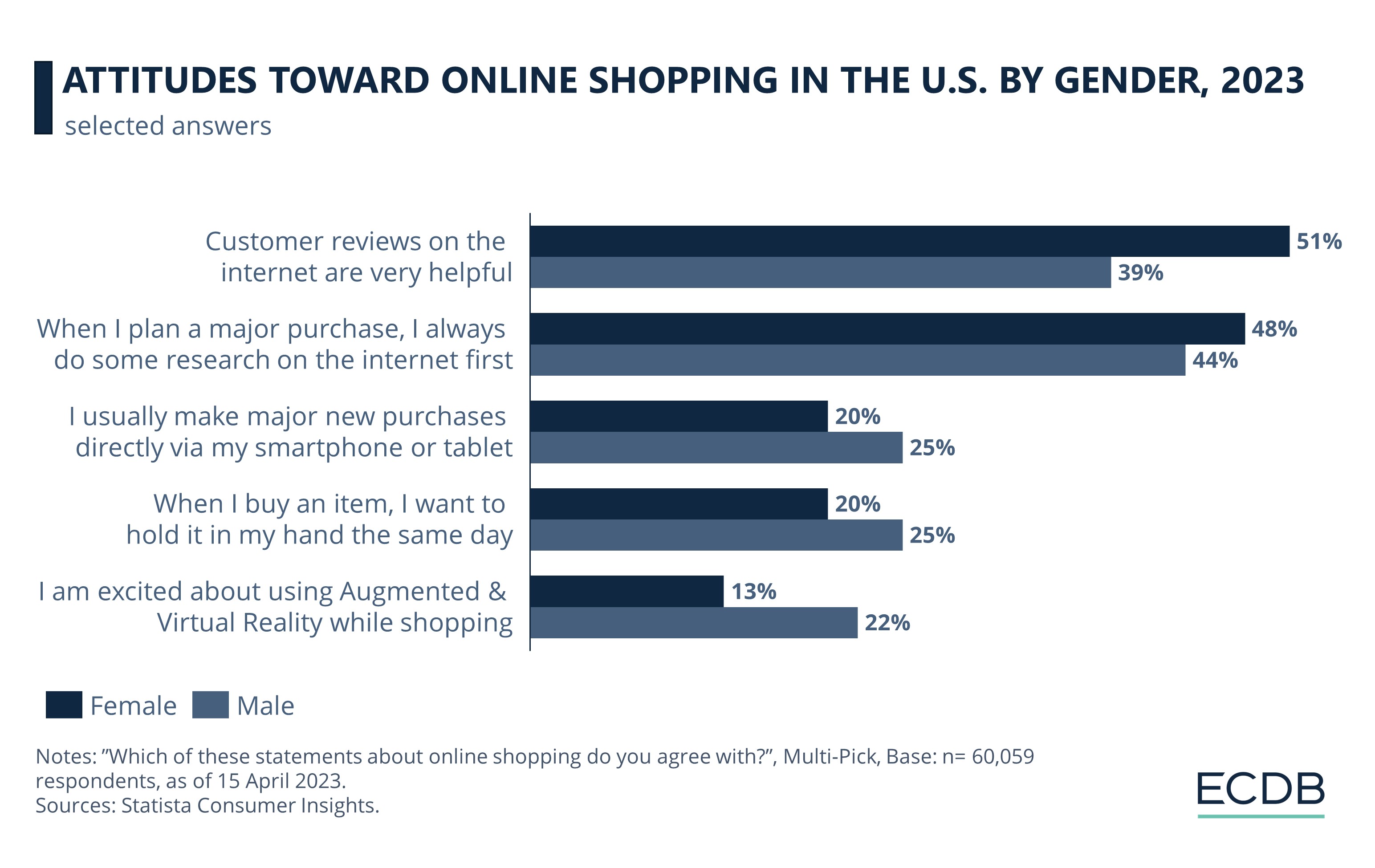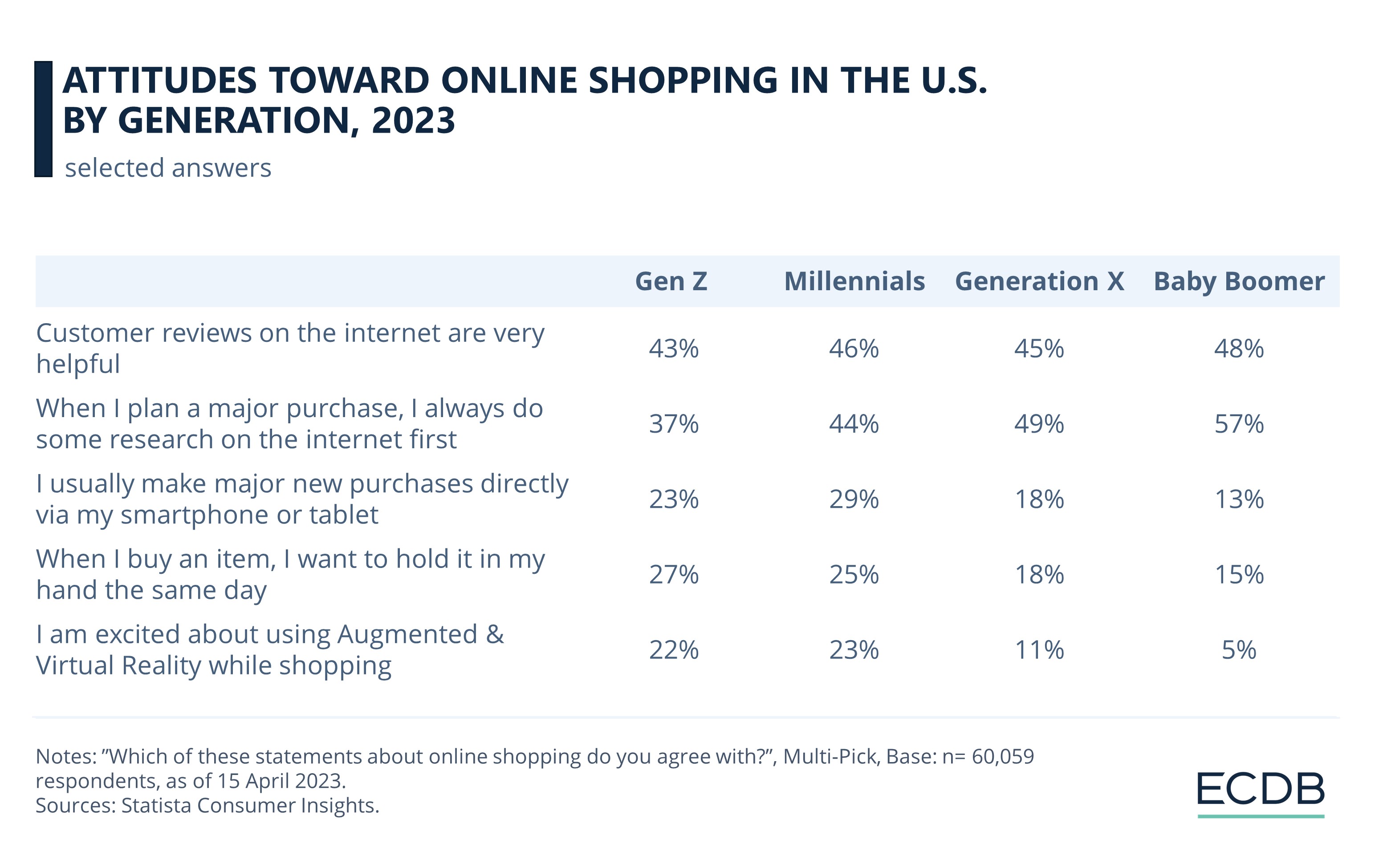Ecommerce: Shopper Attitude
eCommerce Consumer Behavior in the U.S. 2023: Gender and Generation
Online shopping has gained greater popularity in recent years, but perceptions of it in the United States vary according to the shoppers' gender and generation. Find out shoppers' attitudes towards online shopping in this article.
Article by Nashra Fatima | February 13, 2024Download
Coming soon
Share

eCommerce Consumer Behavior in the U.S. : Key Insights
Attitudes towards eCommerce: Customers have different attitudes towards online shopping, which also influences their purchasing behavior. The shopper’s generation and gender both play a role in shaping people’s preferences.
Common practices in online shopping: Some practices, such as conducting internet research and checking customer reviews before making a purchase, find resonance across gender and generational divides.
Openness to experimentation in eCommerce: Innovative approaches in eCommerce, such as the integration of Augmented and Virtual Reality, are more welcome by younger shoppers, in terms of generation, and male shoppers in terms of gender.
In the United States, attitudes towards online shopping differ, depending on the gender and generation of the shopper, per the findings of Statista Consumer Insights.
eCommerce Consumer Behavior by Gender: Males More Excited for Futuristic Methods
In terms of gender, attitudes towards online shopping converge on most fronts except a few.

For males shoppers surveyed, online search before making a major purchase decision is most important, with the highest share - 44% - selecting this option.
A larger share of females (48%) than males conduct online search; however, they trust customer reviews more. At 51%, females outpace males (39%) in this regard, a fact that suggests women’s higher confidence level in reviews and ratings.
34% of males and 35% of females prefer buying products from multiple sellers on one marketplace, indicating that the use of online marketplaces for shopping cuts across the gender divide. The reasons for this preference can include greater convenience, value, and variety of products. A recent study by Digital Commerce 360 found that shoppers find marketplaces attractive as they perceive there is a larger range of products on offer on these eCommerce platforms.
More differentiation is visible when it comes to shopping directly via smartphone, with a larger share of men (25%) than women (20%) adopting this practice. The reason to shop on a smartphone includes saving time, quicker research, and finding better prices. As online shoppers, particularly males, become comfortable with smartphone shopping, it presents a marketing opportunity for retailers to target their consumer base on their preferred platform.
The gender gap amongst preferences is most stark when it comes to the integration of experimental technology in eCommerce, with a bigger share of men (22%) than women (13%) excited about using AR and VR in online shopping in the future. This could be a helpful tip to integrate innovative technologies, specifically for businesses targeting males.
Older Shoppers More Likely to Conduct Internet Research Before Purchase
When it comes to different generational cohorts, the views about online shopping diverge on the use of futuristic approaches. However, they coincide on prevalent practices such as internet research before major purchase decisions and reading customer reviews.

The practice of conducting internet research before making an online purchase strengthens with the shopper’s age, with the youngest preferring it the least: Gen Z (37%), Millennials (44%), Gen X (49%) and Boomers (57%).
For customer reviews on the internet, there exists one minor difference in the pattern: Boomers (48%) and Millennials (46%) prefer it more than Generation X (45%) and Gen Z (43%). For businesses catering to Boomer consumers, it may help to focus more on increasing user-generated content about their products, since it appeals to their target demographic.
On the other hand, when it comes to using modern technology like AR and VR in eCommerce, Gen Z (22%) and Millennials (23%) are considerably more excited about the prospect than Generation X (11%) and Boomers (5%). The reason can be that customers from these generations are digital-first; they are also more familiar with cutting-edge technologies. The effect may thus reverberate in their expectations from eCommerce, among other areas of life.

Click here for
more relevant insights from
our partner Mastercard.
Related insights
Deep Dive
Next Generation eCommerce: Key Trends Shaping the New Age of Online Retail
Next Generation eCommerce: Key Trends Shaping the New Age of Online Retail
Deep Dive
Google's AI Project Jarvis Could Change Online Shopping
Google's AI Project Jarvis Could Change Online Shopping
Deep Dive
The Customer Journey in Online Shopping: It Begins with Search Engines
The Customer Journey in Online Shopping: It Begins with Search Engines
Deep Dive
TikTok Shop Expands Operation in the United States
TikTok Shop Expands Operation in the United States
Deep Dive
Fast Fashion Online Market: Fast Fashion Is Not Fair Fashion
Fast Fashion Online Market: Fast Fashion Is Not Fair Fashion
Back to main topics